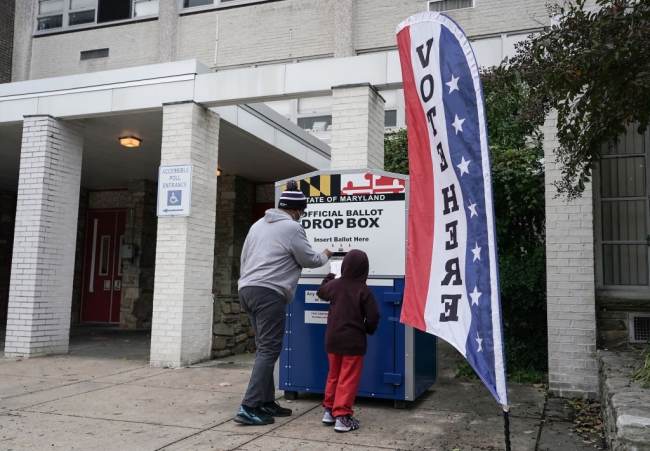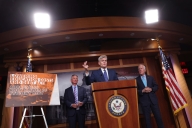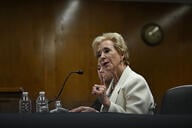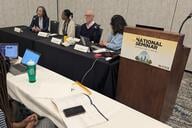You have /5 articles left.
Sign up for a free account or log in.

A mother and son drop a ballot off in Baltimore on Nov. 3.
Getty Images/J. Countess
The nation continues to wait for swing states to count presidential votes, but many local measures have already been called. Voters in several states and counties decided on ballot measures that could provide more resources to community colleges, which are even more financially strapped than usual due to the COVID-19 pandemic.
Bonds for Modernization and Safety
Some community colleges won big Nov. 3.
Voters in Prince George's County in Maryland voted overwhelmingly to let the county issue bonds to improve community college facilities.
The $121.7 million bond will be used on projects through 2026 for Prince George's Community College. It will renovate the more than 40-year-old Largo Student Center to meet energy specifications and provide more space for social events. It will also renovate Marlboro Hall to include technological innovations for the classrooms.
Citrus College in Glendora, Calif., won approval for a $298 million bond on the Los Angeles County ballot that will upgrade its infrastructure to improve its safety. The bond will be used to remove leaky roofs, mold and lead paint, as well as ensure buildings meet safety regulations for earthquakes and fire and can provide clean drinking water.
The money will also be used to upgrade classrooms and laboratories and provide resources to student veterans preparing to transfer or enter the workforce. The improvements and additional supports are meant to improve the retention of teachers and overall quality of education.
The college is encouraged by the results, said Melissa Utsuki, executive director of communications and external relations at the college.
"Before Measure Y was placed on the ballot, residents, stakeholders and community leaders across the district were engaged to identify the vision and priorities for our own local higher education goals while dealing with COVID-19," she said in an email. "Measure Y was designed to be a part of the local and regional economic recovery plan, and we wanted our local voters to decide on this important issue."
The extra resources are more important now than ever due to the pandemic, she said. The funds will help make the campus safe and secure for when students return.
Elsewhere in California, some results weren't yet clear. Voters in Santa Clara County voted on whether to give San Jose-Evergreen Community College District $4.5 million per year for nine years through an annual parcel tax increase. The money would be used to provide students with assistance for basic needs as well as prepare them to transfer to a four-year college. It would also go toward attracting and retaining faculty and providing career and job training. The measure needs two-thirds of the vote to pass and had about 61 percent by Thursday afternoon.
A second measure would issue a property tax levy of $17.5 per $100,000 in assessed value to support an $858 million bond for the district to use to upgrade facilities that prepare students for more technical careers, such as those in emergency response and health care, as well as recruit faculty and modernize and repair classrooms. It needs 55 percent of the vote to pass and had about 53 percent by Thursday afternoon.
New Avenues of Funding
Maryland voters have opened up a new resource for education funding with the passage of Question 2. The measure asked voters to authorize sports and events betting at licensed facilities, and it passed with about two-thirds of the vote.
This new revenue is slotted to go toward education in the state. How it will be divvied up among the sectors, though, is yet to be determined, said Roger Hartley, dean of the College of Public Affairs at the University of Baltimore.
The ballot initiative itself is vague and leaves the distribution of the revenue up to the Legislature. It will likely be used to fund the recommendations from the Kirwan Commission report, Hartley said.
The commission is led by William "Brit" Kirwan, a former chancellor of the University System of Maryland, and it recommends investing just under $4 billion per year into public schools. Funding for the recommendations is a big issue in the state, Hartley said, as the Democratic House called for raising taxes but the idea was rejected by Larry Hogan, the Republican governor.
There's still a chance that the sectors will lobby for money to go toward issues outside the Kirwan Commission's recommendations, though, he said. It's especially likely with the state of higher education revenue due to the pandemic.
"It’s really important, especially now that state and local governments have been super constrained in their budgets by the coronavirus, that there be an alternate source of funding for schools," Hartley said, but "it’s such a big bill that there’s still going to be a fight."
Another question is how COVID-19 could impact this revenue. Gordon Medenica, Maryland Lottery and Gaming director, doesn't expect it to have much of an effect.
"The revenue potential from sports betting is modest. It won't be a game-changer, but it will provide an ancillary line of business for the casinos that should help drive foot traffic," he said.
Bernard Sadusky, executive director of the Maryland Association of Community Colleges, said new revenue wouldn't directly impact community colleges but would have indirect effects if put toward the Kirwan Commission recommendations. One recommendation is to expand the state's dual-enrollment program and pay the costs for all students who qualify for those courses. That could help revenue at the two-year colleges, Sadusky said.
The commission also recommends building up and improving career and technical education in the state. Many of those programs are partnerships between school systems and community colleges, so this could also boost enrollment, he said.
"I'm encouraged that the state is looking for additional resources. If not, it would be difficult to fund the report recommendations and would put us in opposition with K-12 for existing state funds," Sadusky said.
He believes it's premature to assume that the revenue stream will be used for items beyond those on the Kirwan Commission report, but if it is, the association would lobby for funds.
"We’re in difficult times," he said. "Every state should be looking for additional revenue sources."
In Colorado, another measure related to gambling could help community colleges. Amendment 77 will let residents in cities that allow gambling to increase or remove bet limits and approve new casino games without a statewide vote. Individual wagers are currently capped at $100. Gaming tax revenue can also now be used by community colleges for programs that improve student retention and credential completion.
Tough Hit in California
Proposition 15 in California suffered a narrow loss, with the Associated Press reporting 51.7 percent of votes opposed. The proposition would have taxed commercial properties worth more than $3 million at their fair market value, rather than the value at the time they were purchased. It was a revision of Proposition 13, passed in 1978. Opponents argued that it would have serious ramifications on businesses due to the economic fallout of the COVID-19 pandemic.
It would have generated about $6.5 billion to $11.5 billion in revenue each year, which would have included a 40 percent allocation for K-12 schools and community colleges. The state's community colleges could have received as much as $500 million annually.
The Board of Governors of the California Community Colleges passed a resolution earlier this year in support of the proposition, urging residents to vote for it in light of the coronavirus.
"The Board of Governors supported Prop 15 because of the significant resources it would have brought into our system to continue advancing equity and success for our students," Paul Feist, vice chancellor of communications and marketing, said in a statement. "We will continue to advocate for the funding necessary to serve our 2.1 million students."




